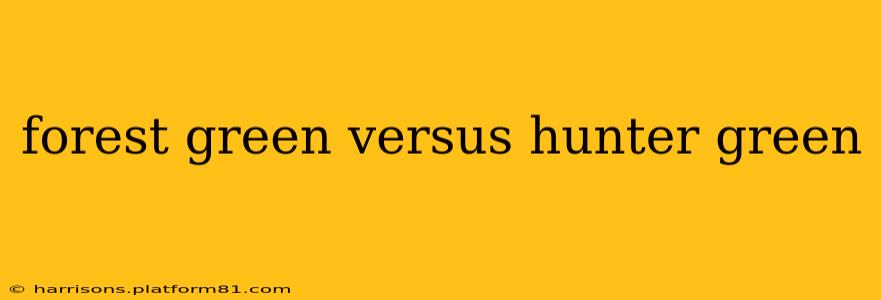Choosing the right shade of green can significantly impact the overall look and feel of a project, whether it's painting a room, choosing fabric for upholstery, or selecting the perfect outfit. Two popular choices often leave people wondering about the nuances: forest green and hunter green. While both evoke images of nature's rich hues, they possess subtle yet distinct differences. This article will delve into the key characteristics of each, helping you confidently select the perfect green for your needs.
What is Forest Green?
Forest green is a deep, rich green reminiscent of lush forests teeming with life. It often leans slightly towards the blue-green side of the spectrum, incorporating a hint of teal or blue undertone. This creates a more serene and calming effect, often associated with tranquility and natural beauty. Think of the deep shade of a dense canopy, dappled with sunlight. It's a classic, versatile color suitable for various applications, from sophisticated interiors to outdoor accessories.
What is Hunter Green?
Hunter green, on the other hand, is a darker, more muted green. It's often described as a deeper, more earthy tone compared to forest green. While it still embodies the natural world, it carries a stronger sense of ruggedness and masculinity. It often contains more yellow undertones, giving it a slightly less cool and more grounded feeling. Imagine the color of well-worn leather hunting boots or the dense foliage of a woodland path. Hunter green exudes a sense of history and tradition.
What's the Difference Between Forest Green and Hunter Green?
The core difference lies in the undertones and the overall saturation of the color. Forest green tends to be brighter and slightly more vibrant, leaning towards cooler tones with subtle blue undertones. Hunter green is generally darker, more subdued, and warmer due to its subtle yellow undertones. This warmer hue gives it a more grounded and earthy quality. Think of it like this: forest green is the vibrant green of new spring leaves, while hunter green is the deeper, richer shade of leaves in late autumn.
What is the Difference in RGB and Hex Values?
The precise RGB and hex values can vary slightly depending on the specific shade and the color palette used, but generally:
- Forest Green: Will have a higher blue component in its RGB values, resulting in a cooler overall tone. Hex codes might fall around #228B22 or similar.
- Hunter Green: Will have a higher yellow component and lower blue, resulting in a warmer, more earthy tone. Hex codes might fall around #3A5FCD or similar, but often have a less saturated appearance.
Which Green is Best for Painting a Room?
The best choice for painting a room depends on the desired atmosphere and the room's lighting.
- Forest green: Creates a calming and serene atmosphere, especially in rooms with ample natural light. It works well in bedrooms, bathrooms, and living rooms aiming for a tranquil feel.
- Hunter green: Creates a more dramatic and sophisticated look, suited to rooms with less natural light. It can work well as an accent wall or in a library or study where a more grounded atmosphere is desired.
Which Green is Best for Clothing?
Both colors work well in clothing, but the choice depends on personal preference and style.
- Forest green: Is generally more versatile and can be incorporated into various styles.
- Hunter green: Can be more striking and bold, often seen in more rugged or classic styles.
What are Other Similar Colors to Forest Green and Hunter Green?
Several other greens share similarities with forest and hunter green, including olive green, emerald green, and sage green. Olive green is often a more muted and brownish-green, while emerald green is more vibrant and jewel-toned. Sage green is a lighter, more grayish-green. Understanding these related shades can broaden your color palette options even further.
By understanding the subtle yet significant differences between forest green and hunter green, you can make informed decisions about your color choices across various applications. The key is to consider the undertones, the overall level of saturation, and the mood you want to create. Remember to test the colors in your specific environment to ensure they look exactly as you envision.
